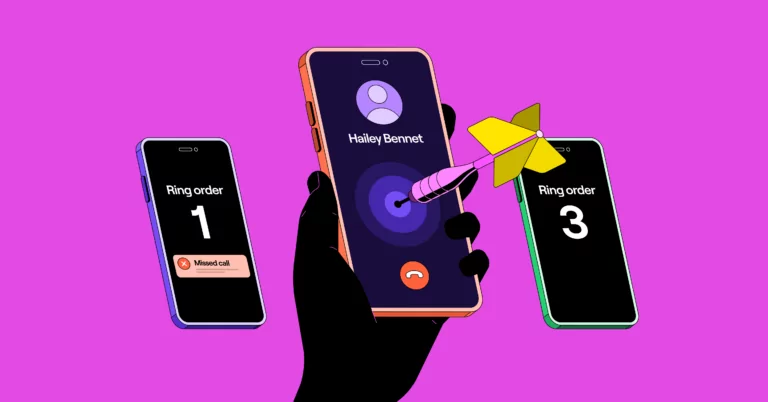If your business receives calls from customers, you know how important it is to make sure there’s always a team member available to answer the phone. Queue the hunt group — a call routing strategy that can reduce wait times and drastically improve your customer experience, which helps to build better relationships with your callers.
Your clients are busy people, and they can’t afford to wait long for someone to pick up the phone. Even if you have team members out of the office, a hunt group ensures your customer calls reach the next available rep in the group. You can also have your teammate’s devices ring simultaneously so the call goes to any representative who answers first. That way, your business is always reachable to clients during business hours.
Here’s a breakdown of everything you should know about hunt groups, including their benefits, the different types of hunt groups, and how you can set one up for your business.
What is a hunt group?
At a high level, a hunt group is a type of call routing tool designed to send incoming calls to a predetermined group of people in a preset order. This call flow may include your customer service team, your contact center, or a member of your sales department.
Hunt groups are most useful for businesses with high call volumes. The right hunt group settings keep your phone lines open and ensure your call group members can get work done without staying glued to their phones.
Many VoIP providers, as well as PBX systems, offer a hunt group feature for call distribution. The best business phone systems let you customize your settings so you can easily connect callers to the right person at the right time.
You can set up hunt groups in many different ways, such as using a shared number or creating a custom ring order. You can also ring all numbers in the hunt group simultaneously so the first person to pick up gets the call.
Keep reading to learn more about the benefits of hunt groups for your business.
Benefits of hunt groups
The biggest benefit of using a hunt group is speed. Customers expect an instant response from your business and don’t have time to wait on hold. If you don’t pick up their first call or send them straight to voicemail, your competitor will likely get the next call.
Let’s say you discover some mice in your home and need to contact a pest control company. You call business A, but don’t get an answer. You call business B, but hang up after waiting on hold for five minutes. Finally, you call business C, and they pick up your call on the second ring. Who’s most likely to get your business?
Hunt groups reduce the chances of customers reaching your voicemail instead of a live representative. Since hunt groups route calls to multiple people either simultaneously or sequentially, there’s almost always someone around to pick up the phone.
Here are a few more benefits of using hunt groups for your business:
- Faster responses: Using a hunt group as part of your call routing strategy can quickly get callers to a live representative. Call distribution also reduces wait times and callbacks, which is an easy way to prevent playing phone tag and make a good first impression with your customers.
- Fewer missed opportunities: A VoIP hunt group alerts multiple team members to each incoming call. Everyone with a shared number (or a number that’s part of the hunt group) receives simultaneous or sequential ringing until someone picks up. Remember: if someone calls your business after finding you on Google, they’re not likely to call again if you don’t pick up or follow up quickly. Hunt groups help you speed up call handling times, which means your speed-to-lead issue = solved.
- Improved call distribution: Want specific team members to have priority on the phone? You can manage hunt groups to determine who should receive calls first. For example, you can have phone calls ring junior members of the group first, then if they don’t pick up, route them to managers. You can also create shared numbers so team members can cover for each other while out of the office or temporarily unavailable.
- More control over incoming calls: Custom ring groups let you define the order in which your team members receive calls. VoIP systems also let you customize ring duration, which you can’t do on most standard mobile phones.
How can hunt groups differ?
When deciding how to distribute calls via hunt groups, you have a few choices. Five main options are:
1. Sequential hunt groups
Also known as linear hunt groups, sequential hunt groups send incoming calls to the first team member in a call sequence unless they are on another call. For example, an incoming call first goes to employee A, then employee B if employee A doesn’t answer. It’s then sent to employee C if B doesn’t answer (and so on).
Sequential hunt groups are a great strategy if you want your first ring to go to the representative with the most experience. Incoming calls go to them by default, and backup teammates are in the queue if they’re not available.
2. Simultaneous hunt groups
With simultaneous hunt groups, incoming calls ring everyone at the same time — employee A, employee B, and employee C — until someone picks up.
💡 Pro tip: For simultaneous ring hunt groups, it’s better to have a longer ring time (such as 30 seconds) since calls don’t cycle through different team members. Other types of hunt groups, like sequential or round-robin, should have shorter ring durations since calls ring each team member for a set amount of time. You can start with ring durations of 10 to 15 seconds and adjust as needed.
3. Random hunt groups
Random hunt groups specify a certain number of ‘batches’ that should receive incoming calls at the same time. This means batch A gets the call first, and if no one in the group picks up, batch B has a chance to pick up. If no one answers the phone and there are no other batches to cycle through, the call goes to voicemail.
4. Round robin or circular hunt groups
Round robin hunt groups (sometimes called circular hunt groups) ensure incoming calls go to the next representative ‘in line’ to pick up the phone. For example, if employee A answered the last call, the next incoming call first goes to employee B. If employee B doesn’t pick up, it goes to employee C (and so on).
What happens when your call reaches the end of your hunt group? The ringing simply starts over at the first representative’s phone number until someone picks up the phone.
5. Longest idle time hunt groups
Longest idle time is exactly what it sounds like — incoming calls route to the team member who hasn’t answered the phone in the longest time.
Large call centers are more likely to use this strategy, especially since it ensures all team members share responsibility for incoming calls. You can also use this strategy to manage the burden of high call volumes so team members can take breaks without feeling chained to their desks.
So, how does a hunt group work?
A hunt group is relatively easy to set up for your team when you use VoIP software. We’re going to use OpenPhone as an example here since we offer several options for setting up hunt groups.
Just follow these four steps to save time for your customers and team members alike:
- Set up teammates with specific phone numbers: Specific colleagues can have their own numbers or you can set up shared numbers, which allow your whole team or department to share one phone number.
- Indicate call availability: You can set business hours on any phone number so callers hear an away voicemail greeting when your team is off for the day. Plus, you can set a separate voicemail greeting if your team doesn’t pick up during business hours. Specific team members can set their own work schedules in OpenPhone so they only receive calls during their scheduled shifts. Or if they’re temporarily unavailable, such as in a meeting, they can enable Do Not Disturb.
- Choose a ring order with a shared number: You can prioritize who receives calls first to a specific phone number using a custom ring order, available on our Business plan. Alternatively, you can set a random or simultaneous ring order for the hunt group.
- Teammates receive incoming calls based on ring order: During business hours, the inbound call rings representatives for the indicated duration until someone picks up the phone. If no one picks up, the call goes to voicemail. Setting up auto-replies for new voice messages or missed calls can prevent leads from slipping through the cracks.
How to easily set up a hunt group in OpenPhone
With OpenPhone’s hunt groups, you can choose between many different ring order options so your team has more control over incoming calls.
Here’s how easy it is to set up a hunt group in OpenPhone:
Invite team members
Add team members from the “Members” section, where you can either let them select a new dedicated phone number for their work or give them shared access to an existing phone number in your workspace.
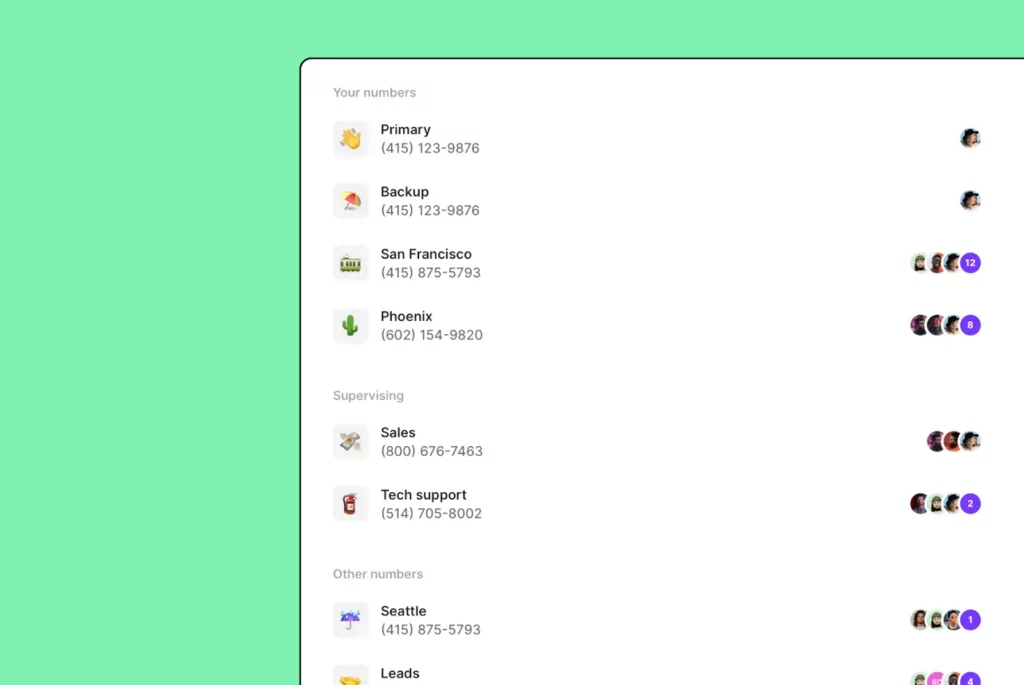
Your colleagues can also use multiple phone numbers with OpenPhone, whether your business needs local numbers across different area codes to appear more relevant to your customers or if a team member needs to cover for a colleague who’s out.
Set business hours and work schedules
1. Add business hours to specific OpenPhone numbers from the “Phone numbers” section.
2. Select the specific phone number you wish to add business hours to.
3. Scroll down to the “Call flow” section and enable business hours.
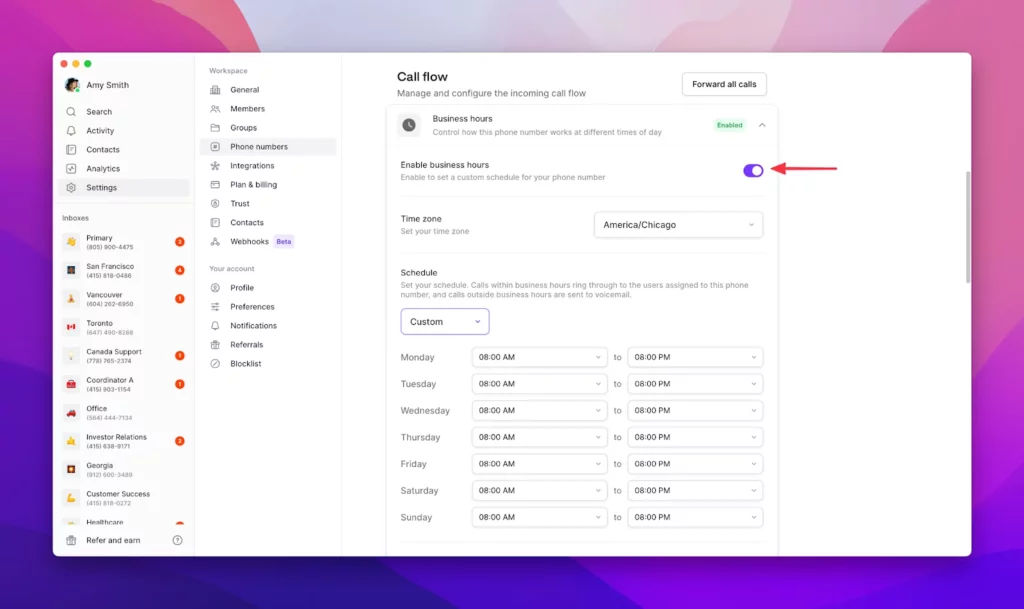
4. Choose the appropriate time zone from the drop-down menu and enter the hours for your (or your team’s) daily availability. You can set the same hours every weekday or add custom hours if they vary.
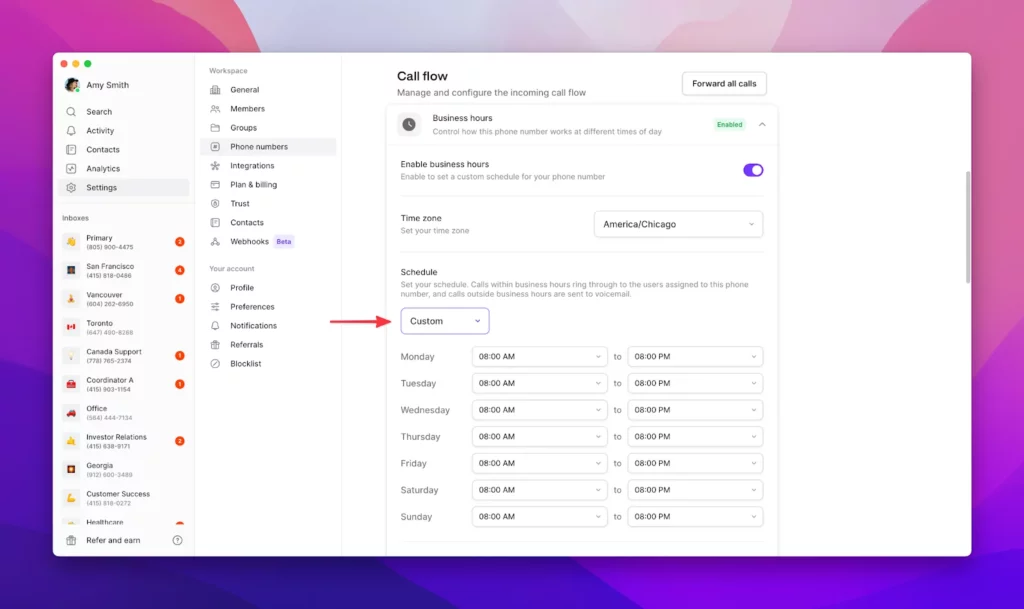
5. You can set up a custom away voicemail greeting by clicking “After-hours voicemail” on the desktop app or tapping “After-hours voicemail” on mobile. You have the option to upload an audio file, record yourself, or use text-to-speech on the web app.
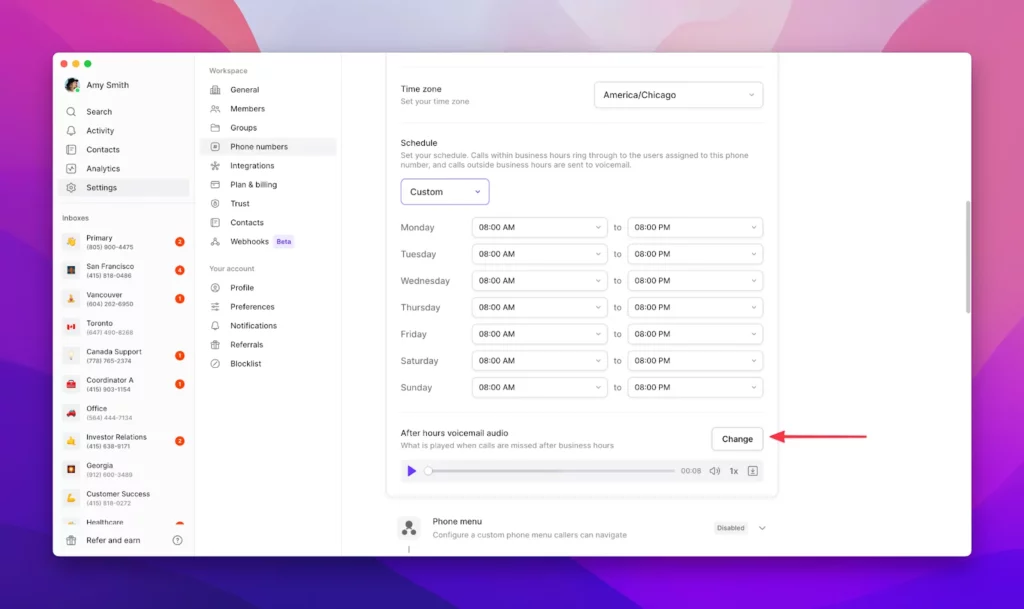
If your team receives incoming calls in shifts, you can set up a work schedule for individual team members.
Set up a ring order
1. In the “Call flow” section for your phone numbers, click “Connect.”
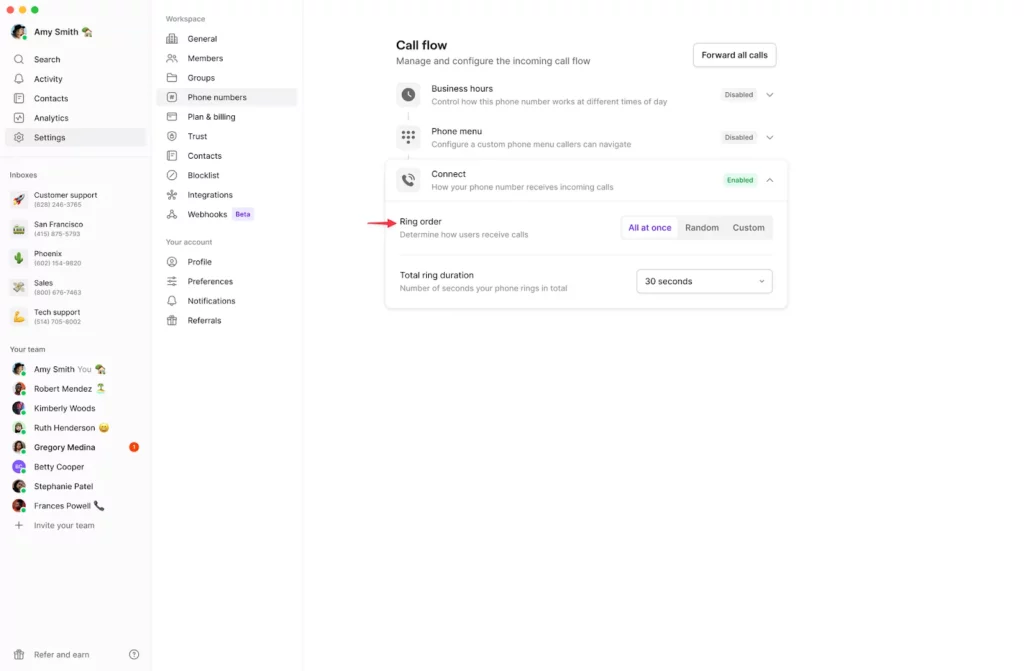
2. Select the type of ring order you want for your hunt group:
- All at once: The default option for new OpenPhone numbers. Incoming calls automatically ring all team members who use the shared number during that number’s business hours and who are available (not those on Do Not Disturb or who have a work schedule that shows them as unavailable).
- Random: Allows you to set a group size based on the number of team members who share a number and set a call ring duration for each group. When one batch doesn’t answer, the next group of representatives receives the incoming call based on the ring duration.
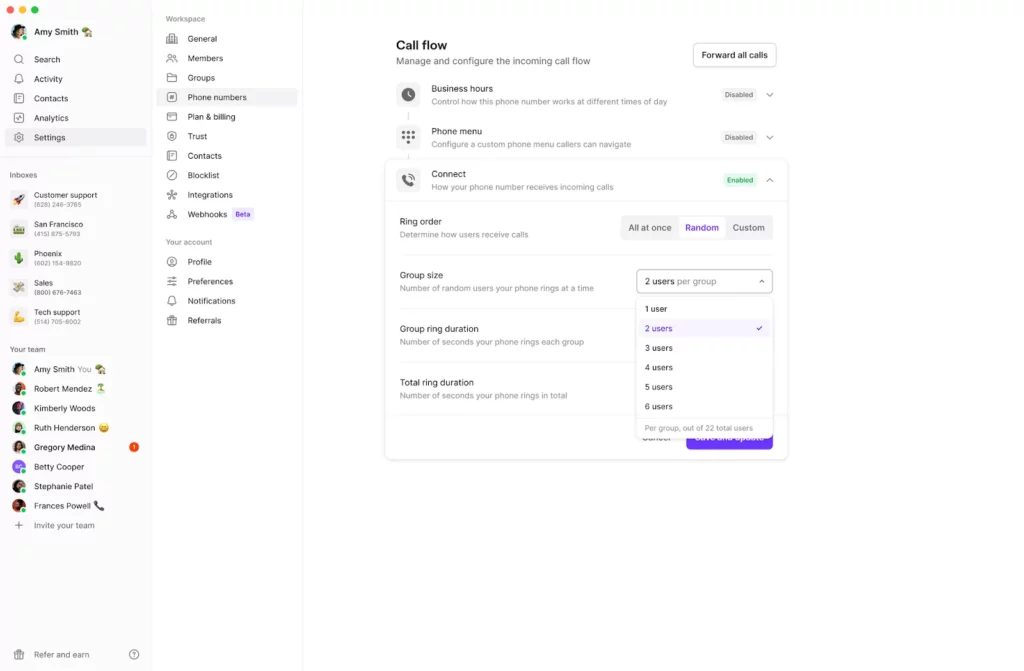
- Custom: Lets you customize which members are a part of which specific group, sort the ring order within each group so specific teammates can take calls first, and set the ring duration for each group. Learn how to set up a custom ring order.
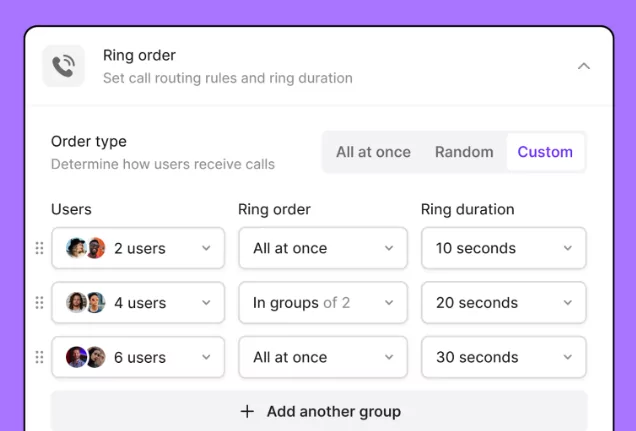
💡 Note: Custom ring order features are available to Business plan users. If you’re a current OpenPhone Starter user, learn how to upgrade.
Use OpenPhone for hunt groups
Using a hunt group to route incoming calls helps your team explore every opportunity that comes their way. It’s also a great call management strategy to improve customer relationships, as it helps your team pick up the phone quickly.
With OpenPhone, you can set up and organize a hunt group within minutes, allowing your team to work more productively. You can also help team members collaborate with context using a shared inbox available on our Starter plan and up.
You can set up a hunt group for your team in 15 minutes or less by signing up for OpenPhone’s seven-day free trial.
FAQs
A ring group usually refers to simultaneous ringing, which is a call-managing strategy designed to ring every device connected to a shared phone number. A hunt group gives more control over how you want to distribute incoming calls to team members, such as ringing certain groups or individuals before others.
Call forwarding is a phone management feature designed to automatically redirect incoming calls to a different telephone number. In contrast, hunt groups automate the call forwarding process by directing calls to specific teammates in a predetermined order. You also don’t have to forward calls with virtual phone numbers, since your team receives incoming calls on personal devices (think computers, laptops, tablets, or smartphones) without having to use their personal numbers.
You should use hunt groups to customize ring duration based on the number of team members in your hunt group. Smaller groups should have a longer duration (such as 15 seconds), and larger groups should have a shorter duration (such as 10 seconds). This ensures clients aren’t waiting too long, but still gives your team enough time to pick up the phone.
